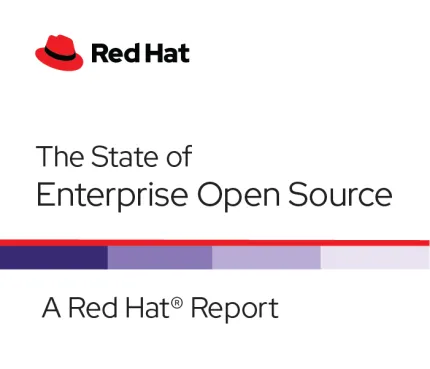We’re now in the third year of our The State of Enterprise Open Source report in which we probe the use of and attitudes about enterprise open source. This year we conducted interviews with 1,250 IT leaders worldwide. They weren’t necessarily Red Hat customers and were unaware that Red Hat was the sponsor of this survey, helping us to avoid biased or influenced responses. Most of the questions were repeats from prior years, allowing us to explore trends over time, but we also threw in a few new ones too and got one answer that even we weren’t fully expecting.
We encourage you to read the whole The 2021 State of Enterprise Open Source: A Red Hat Report. However, here are some highlights:
-
Digital transformation is a top use case for open source
-
Enterprise open source is an innovation engine
-
Security of enterprise open source is an important benefit
-
Vendor participation in open source communities matters
Digital transformation continues to gain in importance
The majority (53%) now say that digital transformation is an important use of enterprise open source, a number that’s climbed 11 points over the past two years. Application development now scores similarly as well.
It’s a busy time for digital transformation efforts generally. Our 2021 Global Tech Outlook also found a digital transformation focus. It was the top non-technical IT funding priority for respondents and 21% were accelerating their plans—possibly a reaction to COVID-19.
Infrastructure modernization remains the most important use cited for enterprise open source in most geographies, although it’s in a tie with digital transformation in EMEA. Given that the roots of open source often lie in infrastructure modernization, this is not surprising. Enterprise open source’s momentum in categories more associated with important business initiatives (like digital transformation) may have been harder to foresee.
Access to the latest innovations is a key benefit
If infrastructure modernization remains an important use of enterprise open source, the historically associated benefit of lower total cost of ownership is now well down the list tied for the sixth spot. Instead, enterprise open source continues its march from being seen as a less expensive and good enough alternative to proprietary software to a place where it is seen as genuinely better.
Better in what way?
For one thing, our respondents say it’s higher quality. That’s the top benefit they see from enterprise open source. Its ability to safely leverage open source technologies comes in at number four.
These dovetail nicely with the second place benefit, access to innovation. Collectively, these benefits cited by the IT leaders in our survey indicate they see enterprise open source as a way to obtain cutting-edge software that they can also deploy responsibly in their businesses.
Beyond quality to security
Security is, in a sense, a form of quality. But this third place benefit cited by our respondents is worth considering on its own for a couple of reasons. For one, security is a white-hot topic. For another, the security impact of source code availability based on analogs with physical security systems used to be a matter of some debate (and occasionally still is).
But the view that open source code carries risk is waning. In fact, in addition to the 30% who see better security as a top three benefit, 87% see enterprise open source as “more secure” or “as secure” as proprietary software.
We also explored attitudes more broadly. 84% indicate that enterprise open source “is a key part of my organization’s security strategy.” 75% say they trust enterprise open source because it undergoes “[...] a stringent vetting process and commercial testing to ensure quality code.”
Where the innovation comes from
 Open source software communities are the places where much of the aforementioned innovation in today’s software industry happens. A glance at all the open source projects in the cloud-native and machine learning spaces gives a good sense of this; our survey’s numbers confirm it. And enterprise open source provides the path for businesses to safely make use of all that innovation.
Open source software communities are the places where much of the aforementioned innovation in today’s software industry happens. A glance at all the open source projects in the cloud-native and machine learning spaces gives a good sense of this; our survey’s numbers confirm it. And enterprise open source provides the path for businesses to safely make use of all that innovation.
Delivering enterprise open source to customers most effectively requires a vendor to actively participate in the upstream open source projects. That’s how we develop the expertise needed to best support our products. It’s what puts us in the best position to influence project directions for the benefit of our customers. But do IT leaders care about any of this? Do they see any difference between vendors who passively consume open source projects versus those who actively help push them forward?
Our guess, when we decided to add this new question was that a few would probably care. We were wrong. I guess we weren’t giving enough credit to the IT leaders who took our survey. 38% are “much more likely” to select a vendor who contributes; another 45% are “somewhat more likely” to do so.
Summing it up
Our three years of enterprise open source studies tell a clear story. IT leaders widely view enterprise open source software as a superior form of software with higher quality, more innovation, and even better security than the alternatives.
Furthermore, they also widely appreciate that the full value of enterprise open source is provided through vendors who actively participate in the open source development model rather than just repackaging open source code. Collectively, it’s a recognition that enterprise open source is increasingly the future of software.
There are even more details in our survey and we invite you to dive into the full results, The State of Enterprise Open Source: A Red Hat Report.
About the author
Gordon Haff is a technology evangelist and has been at Red Hat for more than 10 years. Prior to Red Hat, as an IT industry analyst, Gordon wrote hundreds of research notes, was frequently quoted in publications such as The New York Times on a wide range of IT topics, and advised clients on product and marketing strategies.
Browse by channel
Automation
The latest on IT automation for tech, teams, and environments
Artificial intelligence
Updates on the platforms that free customers to run AI workloads anywhere
Open hybrid cloud
Explore how we build a more flexible future with hybrid cloud
Security
The latest on how we reduce risks across environments and technologies
Edge computing
Updates on the platforms that simplify operations at the edge
Infrastructure
The latest on the world’s leading enterprise Linux platform
Applications
Inside our solutions to the toughest application challenges
Original shows
Entertaining stories from the makers and leaders in enterprise tech
Products
- Red Hat Enterprise Linux
- Red Hat OpenShift
- Red Hat Ansible Automation Platform
- Cloud services
- See all products
Tools
- Training and certification
- My account
- Customer support
- Developer resources
- Find a partner
- Red Hat Ecosystem Catalog
- Red Hat value calculator
- Documentation
Try, buy, & sell
Communicate
About Red Hat
We’re the world’s leading provider of enterprise open source solutions—including Linux, cloud, container, and Kubernetes. We deliver hardened solutions that make it easier for enterprises to work across platforms and environments, from the core datacenter to the network edge.
Select a language
Red Hat legal and privacy links
- About Red Hat
- Jobs
- Events
- Locations
- Contact Red Hat
- Red Hat Blog
- Diversity, equity, and inclusion
- Cool Stuff Store
- Red Hat Summit

